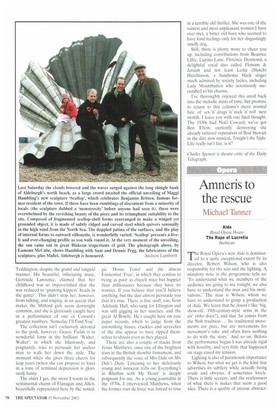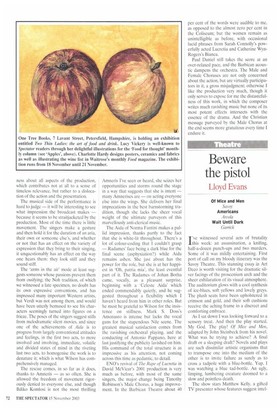Amneris to the rescue
Michael Tanner
Aida Royal Opera House The Rape of Lucretia Barbican
The Royal Opera's new Aida is dominated to a quite exceptional extent by its director, Robert Wilson, who is also responsible for the sets and the lighting. A minatory note in the programme tells us: 'To understand what we members of the audience are going to see tonight, we also have to understand the man and his motivations.' The man is Wilson, whom we have to understand to grasp a production of Aida. We learn that he doesn't like 'big, show-off, 19th-century-style arms in the air' (who does?), and that 'he comes from the Noh tradition. . Its traditional movements are pure, but are movements for movement's sake and often have nothing to do with the story.' And so on. Before the performance began I was already rigid with hostility, and very little that happened on stage eased my tension.
Lighting is also of paramount importance to Wilson, but what we get is the kind that advertises its subtlety while actually being crude and obvious, if sometimes lovely. There is little scenery, and the restlessness of what there is makes that seem a good idea. There is a quality of intense abstract ness about all aspects of the production, which contributes not at all to a sense of timeless relevance, but rather to a dislocation of the action and the presentation.
The musical side of the performance is hard to judge — it will be interesting to see what impression the broadcast makes — because it seems to be straitjacketed by the production. Most of the time there is little movement. The singers make a gesture and then hold it for the duration of an aria, their own or someone else's, and whether or not that has an effect on the variety of expression that they bring to their singing, it unquestionably has an effect on the way one hears them: they look stiff and they sound stiff.
The 'arms in the air' mode at least suggests someone whose passions prevent them from ossifying; the Noh tradition, of which we witnessed a late specimen, no doubt has its own expressive conventions, and has impressed many important Western artists, but Verdi was not among them, and would have been utterly bemused to see his characters seemingly turned into figures on a frieze. The poses of the singers suggest stills from melodramatic silent movies, and since one of the achievements of Aida is to progress from largely conventional attitudes and feelings, in the first two acts, to more involved and involving, immediate, volatile and divided states of mind in the riveting last two acts, to homogenise the work is to denature it: which is what Wilson has comprehensively managed.
The rescue comes, in so far as it does, thanks to Amneris — as so often. She is allowed the freedom of movement rigorously denied to everyone else, and though Ildiko Komlosi is not the most thrilling
Arnneris I've seen or heard, she seizes her opportunities and storms round the stage in a way that suggests that she is intent — many Amnerises are — on acting everyone else into the wings. She delivers her final imprecations in the best barnstorming tradition, though she lacks the sheer vocal weight of the ultimate purveyors of this marvellously anti-clerical music.
The Aida of Norma Fantini makes a pallid impression, thanks partly to the fact that she is white-lit throughout. There's a lot of colour-coding that I couldn't grasp — Radames' face being a dark blue for the final scene (asphyxiation?) while Aida remains ashen. She just about has the power for the role, but she is at her happiest in 'Oh, patria mia', the least eventful part of it. The Radames of Johan Botha came, vocally, as a pleasant surprise, beginning with a 'Celeste Aida' which ended commendably quietly, and he suggested throughout a flexibility which I haven't heard from him in other roles. But he must be grateful to Wilson for the insistence on stillness. Mark S. Doss's Amonasro is intense but lacks the vocal guns for the stupendous Nile scene. The greatest musical satisfaction comes from the ravishing orchestral playing, and the conducting of Antonio Pappano, here at last justifying the publicity lavished on him. His command of the total structure is as impressive as his attention, not coming across this time as pedantic, to detail.
ENO's revival of The Rape of Lucretia in David McVicar's 2001 production is very much as before, with most of the same singers, the major change being Timothy Robinson's Male Chorus, a huge improvement. In the Barbican Theatre about 40 per cent of the words were audible to me, as opposed to the almost zero per cent in the Coliseum; but the women remain as unintelligible as before, with occasional lucid phrases from Sarah Connolly's powerfully acted Lucretia and Catherine WynRogers's Bianca.
Paul Daniel still takes the score at an over-relaxed pace, and the Barbican acoustic dampens the orchestra. The Male and Female Choruses are not only concerned about the action, but are virtually participators in it, a gross misjudgment; otherwise I like the production very much, though it only serves to expose for me the distastefulness of this work, in which the composer writes much ravishing music but none of its most potent effects intersects with the essence of the drama. And the Christian message purveyed by the Male Chorus at the end seems more gratuitous every time I endure it.



























































































 Previous page
Previous page